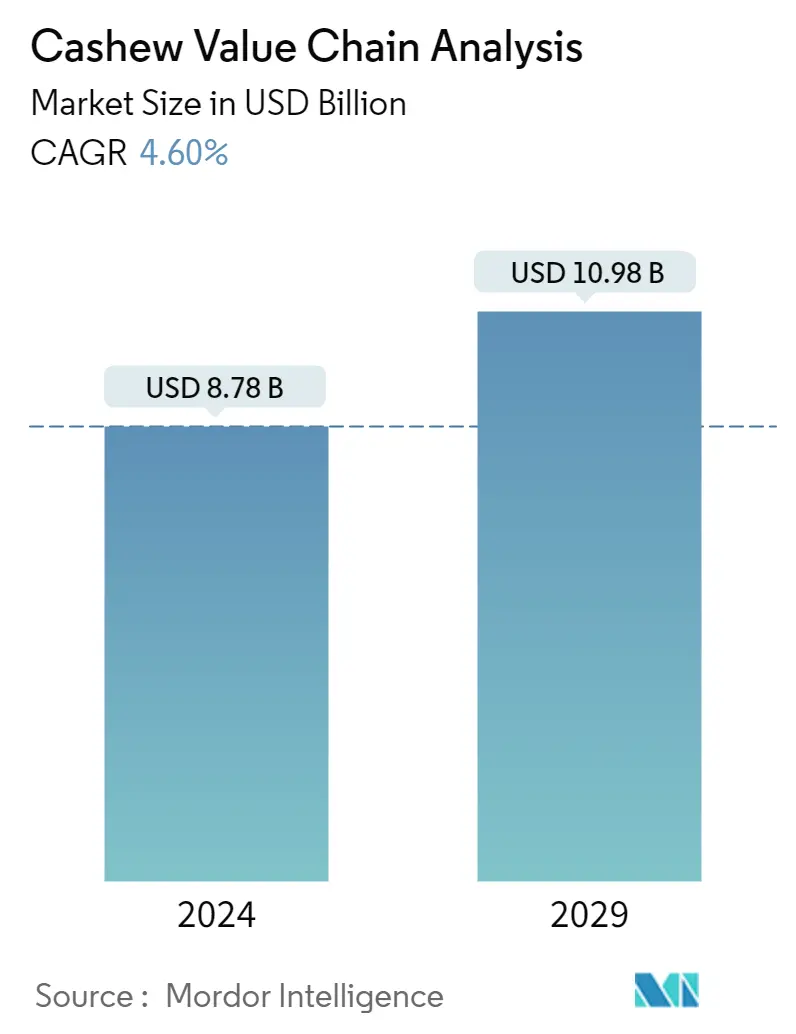Market Size of Cashew Value Chain Analysis

| Study Period | 2019 - 2029 |
| Market Size (2024) | USD 8.78 Billion |
| Market Size (2029) | USD 10.98 Billion |
| CAGR (2024 - 2029) | 4.60 % |
| Fastest Growing Market | Asia-Pacific |
| Largest Market | Europe |
Major Players*Disclaimer: Major Players sorted in no particular order |
Cashew Market Analysis
The Cashew Market size is estimated at USD 8.78 billion in 2024, and is expected to reach USD 10.98 billion by 2029, growing at a CAGR of 4.60% during the forecast period (2024-2029).
- Cashews are expensive because there is just one nut per fruit. Cashews trees must be farmed, harvested, separated from the false fruit, roasted, cooled, cracked open, peeled, sundried, and sorted - and only then can they be sold as raw nuts. The amount of value added is incommensurate with the amount of labor that goes into it. The Cashew Value chain comprises Individual growers and grower cooperatives, Collectors, Local traders, and Exporters.
- Individual growers and grower cooperatives are the stakeholders who produce cashew nuts. Local Middlemen, also known as Pisteurs, are the critical intermediary engaged in collecting raw cashew nuts from the farms and selling them to various buyers, including the buyers under contract, processing units, and traders. The local trader in the distribution of raw cashew nuts involves individual buyers and buyers under contract, who further sell the products to the processing units and the exporters for domestic consumption and exports, and the exporters of raw or processed cashew nuts consist of the export cooperatives and export companies. The export cooperatives purchase the raw cashew primarily from the grower cooperatives and occasionally from the individual growers to meet their export quota.
- Recently, there has been a growing inclination toward using cashew nuts in daily diets and healthy ready-to-eat snacks. The increasing number of cashew-infused product manufacturers has taken young and geriatric consumers by stride with the launch of innovative products, such as cashew-butter yogurt in the United States and roasted, spice-coated cashew nuts in India. Thus, over the long term, the high penetration rate of cashew-based retail manufacturers in the developed and emerging markets and the successful implementation of cashew production and processing initiatives in Africa are expected to drive the cashew market during the forecast period.
Cashew Industry Segmentation
Cashew nuts are edible kidney-shaped nuts, rich in oil and protein, roasted and shelled before being eaten. The Cashew Value Chain Analysis Market Report offers an Overview, Price Markups, Stakeholders, Issues and Challenges in Supply Chain Analysis, and Value Chain Analysis of Cashews.
Cashew Value Chain Analysis Size Summary
The cashew market is poised for steady growth over the forecast period, driven by increasing consumer interest in cashew-based products and the expansion of cashew-infused offerings in both developed and emerging markets. The market's value chain is complex, involving individual growers, cooperatives, local traders, and exporters, all of whom play crucial roles in the production and distribution of cashew nuts. The labor-intensive process of harvesting and processing cashews contributes to their premium pricing, with significant value added at each stage of the supply chain. The market is further bolstered by innovative product launches, such as cashew-butter yogurt in the United States and spice-coated cashews in India, which cater to diverse consumer preferences.
Government initiatives in Africa and Asia-Pacific are enhancing cashew production and processing capabilities, with projects like "The African Cashew Initiative" and trade agreements such as the EU-Vietnam Free Trade Agreement and the Comprehensive and Progressive Agreement for Trans-Pacific Partnership playing pivotal roles. These efforts aim to improve yield and quality, meet international standards, and expand market access. The Asia-Pacific region remains the largest consumer of cashew nuts, with India leading in consumption and Vietnam excelling in production and export. The growing popularity of cashews in daily diets, supported by health policies and innovative marketing campaigns, is driving demand, particularly in China, where nuts are increasingly integrated into the national diet.
Cashew Value Chain Analysis Market Size - Table of Contents
Cashew Value Chain Analysis Market Size FAQs
How big is the Cashew Market?
The Cashew Market size is expected to reach USD 8.78 billion in 2024 and grow at a CAGR of 4.60% to reach USD 10.98 billion by 2029.
What is the current Cashew Market size?
In 2024, the Cashew Market size is expected to reach USD 8.78 billion.

